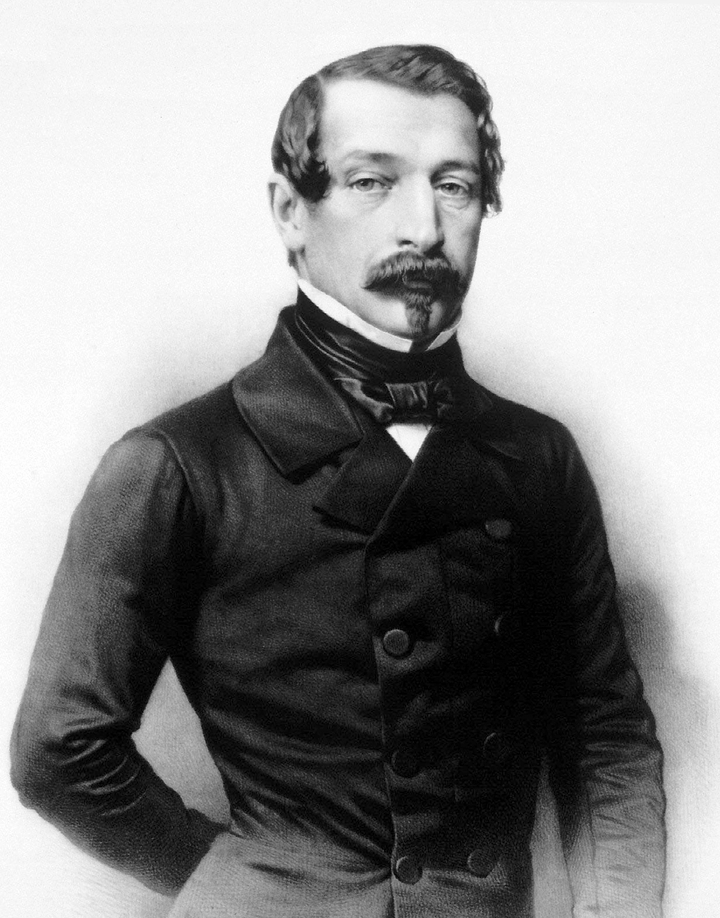
© La Documentation française, Lafosse d’après nature
20 April 1808
Charles-Louis-Napoléon Bonaparte, third son of Louis Bonaparte, King of Holland, and Hortense de Beauharnais, daughter of Empress Joséphine, was born in Paris. He lived in exile after the fall of the Empire and grew up in Augsbourg, Arenenberg and Rome. He spent all of his summers in Italy where he developed sympathy for independence (carbonaro) movements.
1830s
Louis-Napoléon began to plot, persuaded that France wanted a Bonaparte to drive out Louis-Philippe.
1835
He attempted for a first time to return to France via Strasbourg, by creating a people’s uprising. The insurgents were swiftly arrested and the revolt quelled. Louis-Napoléon Bonaparte’s family condemned his attempt.
21 November 1836
Exiled, the Prince boarded a ship heading to the United States.
August 1837
With a fake American passport, he was able to go to Switzerland to see his dying mother.
22 August 1837
To end tensions between Switzerland and France, which called for his expulsion, he went to England, where he prepared another coup d’état.
1840
Wishing to take advantage of the fervent Bonaparte movement triggered by the return of Napoleon’s ashes from Saint Helene, he left for Boulogne-sur-Mer. He was wounded and arrested. He was sentenced to life imprisonment at the Fort de Ham in Picardie, during which time he studied and wrote.
1844
He published one of his most famous works De l’extinction du paupérisme, in which he expressed his interest in economic and social issues.
25 May 1846
He escaped prison disguised as a manual labourer and moved to London.
In favour of the Revolution of 1848 ending the reign of Louis-Philippe, Louis-Napoléon tried to return to France legally.
1848
He was elected to hold a seat in the Assembly in September.
After the Constitution of the Second Republic was enacted on 4 November 1848, he was a candidate in the presidential election and was elected for four years by universal suffrage on 10 December 1848 with nearly 75% of votes.
20 December 1848
He took an oath at the Constituent Assembly and moved into the Élysée Palace.
May 1849
The general elections were won by the Royalists, which generated conflicts with Louis-Napoléon Bonaparte.
Initially, the President’s policy was conservative. He sent troops to Rome to quell a rebellion against the Pope and does not oppose the National Assembly’s passing of the Falloux law on education which moderate Republicans did not like.
31 May 1850
The Assembly passed an electoral law imposing a residence of three years for voters which eliminated three million people from the electorate, particularly tradespeople and seasonal workers.
Louis-Napoléon put pressure to increase the length of his term-of-office while the National Assembly was opposed to any plan for revising the Constitution.
1-2 December 1851
A decree dissolved the National Assembly and re-established universal suffrage. Despite a few uprisings that were severely repressed, the coup d’état was approved and the referendum on new institutions received a majority of votes.
January 1852
A new constitution extended the President’s term-of-office to 10 years.
7 November 1852
A senatus consultum re-established the imperial regime that was confirmed by a referendum.
2 December 1852
The Second Empire began.
29-30 January 1853
He married Eugénie de Montijo, Countess of Teba, and they had a son, Eugène, born in 1856.
1854-1856
During the Crimean War, Napoleon III confirmed France’s return to European political life.
1860
The Emperor’s Italian policy – in favour of the unification to the detriment of Austria – made it possible for France to annex, after a referendum, Nice and Savoie.
Under the Empire, France experienced economic progress (creation of a banking system, development of railroads, transformation of big cities). But the failure to establish a Catholic empire in Mexico (1861-1867) and the attitude of paid neutrality (“tipping” policy) when dealing with conflicts between Austria and Prussia weakened the regime.
21 May 1870
A senatus consultum proposing a more liberal regime was passed by an overwhelming majority of more than 7 million votes.
19 July 1870
Following tensions with Prussia regarding the succession of Spain and deceived by the famous Ems Telegram, France declared War on Prussia.
2 September 1870
During the surrender at Sedan, the Emperor was taken prisoner.
4 September 1870
In Paris, deputies (including Léon Gambetta) proclaimed the Republic.
1 March 1871
The Chamber passed a vote to dethrone Napoleon III.
March 1871
The ex-emperor exiled to England.
9 January 1873
He died at the age of 64 in his residence in Camden Place.
Updated : 14 December 2022